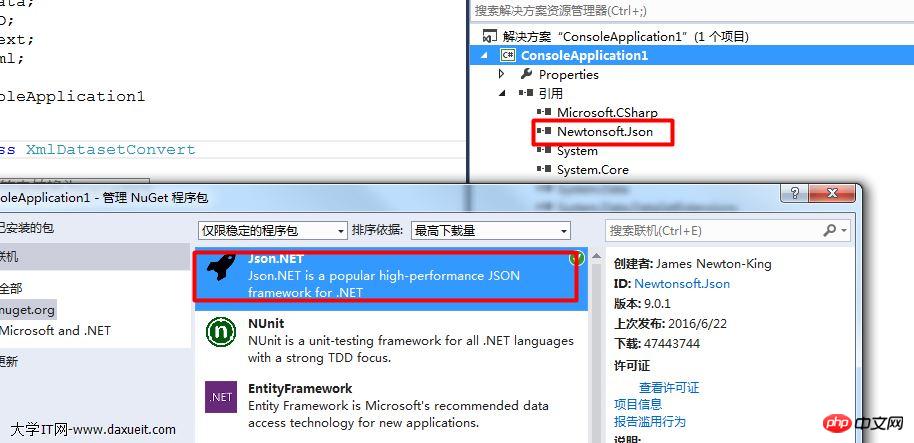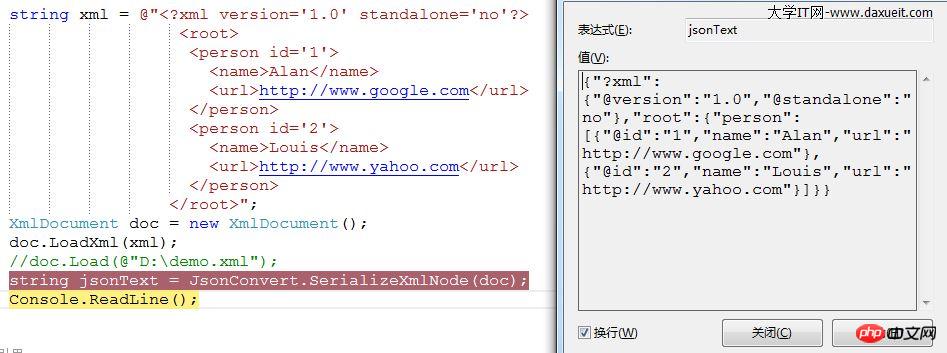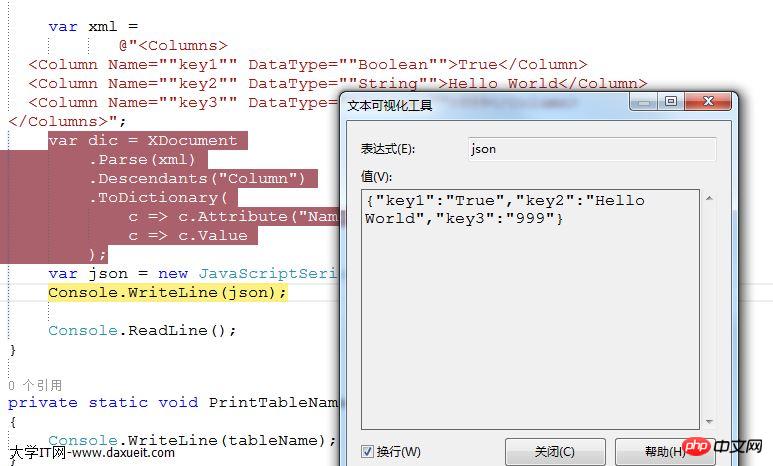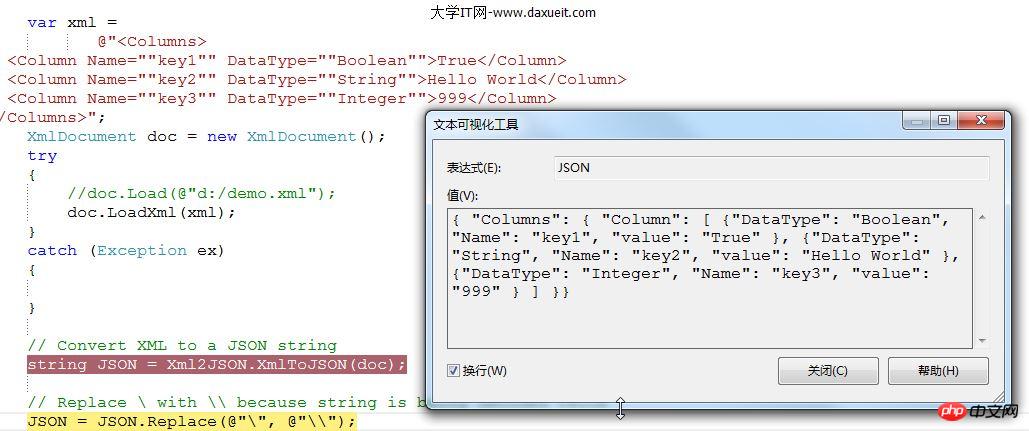
JOSN简介
在本系列的第一篇已经简单比较了XML和JSON 时光机
JSON:JavaScript 对象表示法(JavaScript Object Notation)。 JSON 是存储和交换文本信息的语法。类似 XML。 JSON 比 XML 更小、更快,更易解析。
什么是 JSON?
JSON 指的是 JavaScript 对象表示法(JavaScript Object Notation) JSON 是轻量级的文本数据交换格式 JSON 独立于语言 * JSON 具有自我描述性,更易理解
JSON 使用 JavaScript 语法来描述数据对象,但是 JSON 仍然独立于语言和平台。JSON 解析器和 JSON 库支持许多不同的编程语言。
JSON格式化
尽管有许多宣传关于 XML 如何拥有跨平台,跨语言的优势,然而,除非应用于 Web Services,否则,在普通的 Web 应用中,开发者经常为 XML 的解析伤透了脑筋,无论是服务器端生成或处理 XML,还是客户端用 JavaScript 解析 XML,都常常导致复杂的代码,极低的开发效率。实际上,对于大多数 Web 应用来说,他们根本不需要复杂的 XML 来传输数据,XML 的扩展性很少具有优势,许多 AJAX 应用甚至直接返回 HTML 片段来构建动态 Web 页面。和返回 XML 并解析它相比,返回 HTML 片段大大降低了系统的复杂性,但同时缺少了一定的灵活性
XML2JOSN
借助第三方类库转换

使用NuGet添加第三方类库

<code>string xml = @"<?xml version='1.0' standalone='no'?>
<root>
<person id='1'>
<name>Alan</name>
<url>http://www.google.com</url>
</person>
<person id='2'>
<name>Louis</name>
<url>http://www.yahoo.com</url>
</person>
</root>";
XmlDocument doc = new XmlDocument();
doc.LoadXml(xml);
string jsonText = JsonConvert.SerializeXmlNode(doc);
//{
// "?xml": {
// "@version": "1.0",
// "@standalone": "no"
// },
// "root": {
// "person": [
// {
// "@id": "1",
// "name": "Alan",
// "url": "http://www.google.com"
// },
// {
// "@id": "2",
// "name": "Louis",
// "url": "http://www.yahoo.com"
// }
// ]
// }
//}</code>
对于每个表标签的属性对应JSON中的"@"标签名
如果有多个同名标签就会添加到一个数组集合中
其他方式转换
1.使用.NET Framework中的JavaScriptSerializer类
首先需要确保你的工程或服务器支持.NET 4.0或以上版本的Framework,否则无法找到该类。
通过JavaScriptSerializer来实现。它的名字空间为:System.Web.Script.Serialization
如果要使用它,还须添加
System.Web.Extensions库文件引用
<code> var xml =
@"<Columns>
<Column Name=""key1"" DataType=""Boolean"">True</Column>
<Column Name=""key2"" DataType=""String"">Hello World</Column>
<Column Name=""key3"" DataType=""Integer"">999</Column>
</Columns>";
var dic = XDocument
.Parse(xml)
.Descendants("Column")
.ToDictionary(
c => c.Attribute("Name").Value,
c => c.Value
);
var json = new JavaScriptSerializer().Serialize(dic);
Console.WriteLine(json);</code>
2.手动编写转换类
<code> public class Xml2JSON
{
public static string XmlToJSON(XmlDocument xmlDoc)
{
StringBuilder sbJSON = new StringBuilder();
sbJSON.Append("{ ");
XmlToJSONnode(sbJSON, xmlDoc.DocumentElement, true);
sbJSON.Append("}");
return sbJSON.ToString();
}
// XmlToJSONnode: Output an XmlElement, possibly as part of a higher array
private static void XmlToJSONnode(StringBuilder sbJSON, XmlElement node, bool showNodeName)
{
if (showNodeName)
sbJSON.Append("\"" + SafeJSON(node.Name) + "\": ");
sbJSON.Append("{");
// Build a sorted list of key-value pairs
// where key is case-sensitive nodeName
// value is an ArrayList of string or XmlElement
// so that we know whether the nodeName is an array or not.
SortedList childNodeNames = new SortedList();
// Add in all node attributes
if (node.Attributes != null)
foreach (XmlAttribute attr in node.Attributes)
StoreChildNode(childNodeNames, attr.Name, attr.InnerText);
// Add in all nodes
foreach (XmlNode cnode in node.ChildNodes)
{
if (cnode is XmlText)
StoreChildNode(childNodeNames, "value", cnode.InnerText);
else if (cnode is XmlElement)
StoreChildNode(childNodeNames, cnode.Name, cnode);
}
// Now output all stored info
foreach (string childname in childNodeNames.Keys)
{
ArrayList alChild = (ArrayList)childNodeNames[childname];
if (alChild.Count == 1)
OutputNode(childname, alChild[0], sbJSON, true);
else
{
sbJSON.Append(" \"" + SafeJSON(childname) + "\": [ ");
foreach (object Child in alChild)
OutputNode(childname, Child, sbJSON, false);
sbJSON.Remove(sbJSON.Length - 2, 2);
sbJSON.Append(" ], ");
}
}
sbJSON.Remove(sbJSON.Length - 2, 2);
sbJSON.Append(" }");
}
// StoreChildNode: Store data associated with each nodeName
// so that we know whether the nodeName is an array or not.
private static void StoreChildNode(SortedList childNodeNames, string nodeName, object nodeValue)
{
// Pre-process contraction of XmlElement-s
if (nodeValue is XmlElement)
{
// Convert <aa></aa> into "aa":null
// <aa>xx</aa> into "aa":"xx"
XmlNode cnode = (XmlNode)nodeValue;
if (cnode.Attributes.Count == 0)
{
XmlNodeList children = cnode.ChildNodes;
if (children.Count == 0)
nodeValue = null;
else if (children.Count == 1 && (children[0] is XmlText))
nodeValue = ((XmlText)(children[0])).InnerText;
}
}
// Add nodeValue to ArrayList associated with each nodeName
// If nodeName doesn't exist then add it
object oValuesAL = childNodeNames[nodeName];
ArrayList ValuesAL;
if (oValuesAL == null)
{
ValuesAL = new ArrayList();
childNodeNames[nodeName] = ValuesAL;
}
else
ValuesAL = (ArrayList)oValuesAL;
ValuesAL.Add(nodeValue);
}
private static void OutputNode(string childname, object alChild, StringBuilder sbJSON, bool showNodeName)
{
if (alChild == null)
{
if (showNodeName)
sbJSON.Append("\"" + SafeJSON(childname) + "\": ");
sbJSON.Append("null");
}
else if (alChild is string)
{
if (showNodeName)
sbJSON.Append("\"" + SafeJSON(childname) + "\": ");
string sChild = (string)alChild;
sChild = sChild.Trim();
sbJSON.Append("\"" + SafeJSON(sChild) + "\"");
}
else
XmlToJSONnode(sbJSON, (XmlElement)alChild, showNodeName);
sbJSON.Append(", ");
}
// Make a string safe for JSON
private static string SafeJSON(string sIn)
{
StringBuilder sbOut = new StringBuilder(sIn.Length);
foreach (char ch in sIn)
{
if (Char.IsControl(ch) || ch == '\'')
{
int ich = (int)ch;
sbOut.Append(@"\u" + ich.ToString("x4"));
continue;
}
else if (ch == '\"' || ch == '\\' || ch == '/')
{
sbOut.Append('\\');
}
sbOut.Append(ch);
}
return sbOut.ToString();
}
}</code>
JOSN2XML
借助第三方类库转换

<code>string json = @"{
'?xml': {
'@version': '1.0',
'@standalone': 'no'
},
'root': {
'person': [
{
'@id': '1',
'name': 'Alan',
'url': 'http://www.google.com'
},
{
'@id': '2',
'name': 'Louis',
'url': 'http://www.yahoo.com'
}
]
}
}";
XmlDocument doc = JsonConvert.DeserializeXmlNode(json);
doc.Save(@"D:\json.xml");
// <?xml version="1.0" standalone="no"?>
// <root>
// <person id="1">
// <name>Alan</name>
// <url>http://www.google.com</url>
// </person>
// <person id="2">
// <name>Louis</name>
// <url>http://www.yahoo.com</url>
// </person>
// </root></code>其他方式转换

Das obige ist der detaillierte Inhalt vonDetaillierte Einführung in die Konvertierung zwischen XML und JSON (Grafik und Text). Für weitere Informationen folgen Sie bitte anderen verwandten Artikeln auf der PHP chinesischen Website!
 JSON-Datenformat
JSON-Datenformat
 Was ist JSON?
Was ist JSON?
 So bedienen Sie JSON mit JQuery
So bedienen Sie JSON mit JQuery
 So konvertieren Sie PDF in das XML-Format
So konvertieren Sie PDF in das XML-Format
 Was ist eine .Xauthority-Datei?
Was ist eine .Xauthority-Datei?
 So kaufen und verkaufen Sie Bitcoin auf Huobi.com
So kaufen und verkaufen Sie Bitcoin auf Huobi.com
 Werden Sols-Inschriftenmünzen auf Null zurückkehren?
Werden Sols-Inschriftenmünzen auf Null zurückkehren?
 Welche Software zum Online-Testen der Computerleistung gibt es?
Welche Software zum Online-Testen der Computerleistung gibt es?




